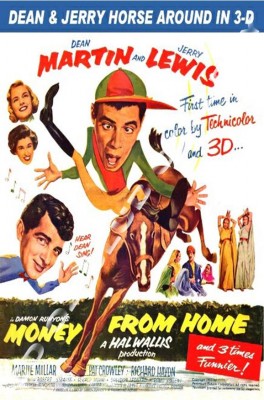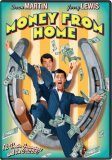| Reviews & Columns |
|
Reviews DVD TV on DVD Blu-ray 4K UHD International DVDs In Theaters Reviews by Studio Video Games Features Collector Series DVDs Easter Egg Database Interviews DVD Talk Radio Feature Articles Columns Anime Talk DVD Savant Horror DVDs The M.O.D. Squad Art House HD Talk Silent DVD
|
DVD Talk Forum |
|
|
| Resources |
|
DVD Price Search Customer Service #'s RCE Info Links |
|
Columns
|
|
|
Money From Home
Martin & Lewis were a bona fide pop culture phenomenon of the early postwar period, equaled only by Elvis Presley and, later on, The Beatles. Their primary appeal was as an unpredictable live act synergizing with their audience; in nightclubs they were a sensation. On live TV, hosting shows like The Colgate Comedy Hour, Martin & Lewis were a bit more restricted but these appearances at least approximated what it was like seeing them at their peak. In the movies, however, Martin & Lewis merely went through the motions, navigating a trail of familiar genre situations already blazed by Abbott & Costello and others. In their earliest films, Lewis's unique comic persona was enough, and toward the end their movies got a big shot in the arm from imaginative director Frank Tashlin. Money from Home doesn't fall into either of these categories, and it's fairly representative of everything that was wrong with their movies.
The film is very loosely adapted from a story by Damon Runyon, the source of material for Abbott & Costello's It Ain't Hay (1943) and Bob Hope's The Lemon Drop Kid (1951), both of which likewise involve horse racing and crooked gamblers, while Runyon's Guys and Dolls was just wrapping its three-year run on Broadway. In Money from Home, ne'er-do-well gambler Honey Talk Nelson (Dean Martin) is in trouble with The Mob; his I.O.U.s are bought up by big-time bookmaker Jumbo Schneider (Sheldon Leonard) who, ahem, "offers" to square things with Nelson if he fixes an upcoming horse race in Maryland.
Dragging along his cousin, vegetarian veterinarian wannabe Virgil Yokum (Jerry Lewis), Nelson concocts a plan to have Virgil impersonate the prized horse's jockey, alcoholic Brit Bertie Searles (Richard Hayden). Meanwhile, Nelson falls for the horse's owner, Phyllis Leigh (Marjie Millar, a pretty and talented actress who died much too young) while Virgil finds a soul-mate in fellow vegetarian veterinarian Autumn Claypool (Pat Crowley).
The film is not one of Martin & Lewis' best. Where Abbott & Costello's movies for Universal tend to have a cost-conscious assembly line feel, all of Martin & Lewis' movies, at least from about this point forward, are weighed down by A-picture gloss. There's too much production and not enough comedy, and at 100 minutes the film seems to go on forever; you could cut 30 minutes out of the picture and not hurt it one bit. Directed with zero flair by George Marshall (not the former General of the Army and Secretary of State, though Wikipedia seems to think so), it pretty much just sits there, and preponderance of bland studio interiors - they don't go anywhere near a racetrack until the film's almost over - doesn't help.
One of the problems plaguing the entire Martin & Lewis oeuvre is Dean's character; as in most of their films together, Dean comes off as a first-class jerk and a lecher besides. Maybe because Lou Costello and Bob Hope could be just as devious (if not as skilled) as Bud Abbott and Bing Crosby, audiences could accept their partner's cruelty and even find it funny. However, with Lewis, Dean's actions, really no worse than anything Bud or Bing inflicted upon their partners, are tantamount to animal cruelty, so pathetically stupid and innocent is Lewis's character: the organ grinder beating up on the little monkey.
With Abbott & Costello and Bob & Bing there was never any doubt these guys were pals, even if they would sell each other out for a pretty girl...or five bucks. But at best Dean merely tolerated Jerry and in their last films together, made at the height of their much-publicized feud, they can't even fake that. In Pardners and Hollywood or Bust, Dean looks ready to slug Jerry at any moment.
For his part, Lewis is pretty insufferable in Money of Home. His childlike love of animals is grating instead of funny, though his romance with Pat Crowley is for the most part cute. Like Lou Costello, Jerry Lewis' persona began as something far more subversive but like Costello, Lewis was stricken with Chaplinitis, and in trying to fashion himself into something universally beloved wound up instead limiting his appeal to, primarily, kids.
There are scattered laughs: Lewis is funny in a drag scene, masquerading as one of the myriad wives of an Arab sheik. Later in the film he does a variation of an old act Lewis did in the Catskills as a teenager, comically lip-synching to records in an awkwardly set-up variation of Cyrano de Bergerac.
When does this story take place? Some sources state the film is set in the 1920s and some characters do wear period costumes. Bootlegging and Prohibition are mentioned, but throughout the film are 1940s sedans and some establishing and wide angle shots clearly place the film in 1953.
Video & Audio
Money from Home reportedly was one of just two films (the other being Flight to Tangier) filmed in both 3-D and 3-strip Technicolor, meaning six separate rolls of films recorded the action on two giant cameras mounted side-by-side and interlocked. The DVD, of course, is not in 3-D and there's nothing in the credits and almost nothing in the film to call attention to this as a "depthy." (By the time it was released the fad was pretty much over and it seems to have played many markets "flat.") There's a brief bit with Jerry falling headlong into the camera lens, but that's about it as far as 3-D showcase scenes. (This reviewer attended a showing of the film in 3-D in Los Angeles in 2003, attended by actress Crowley and writer Hal Kanter, among others. It was fun to watch but the added dimension didn't, as the ads promised, make the film "three times funnier.")
The presentation is okay but imperfect. There's some misalignment of the three Technicolor separations on several reels, and the full-frame format apparently is incorrect. This was a "Panoramic Screen" release in 1.66:1 format originally; at 1.78:1 the cropping is a bit extreme but a 1.66:1 16:9 transfer with black bars on the sides would have done it just right. The opening titles clearly are framed for cropping. The mono sound (no subtitles, no alternate audio options) is adequate as well. Like many 3-D releases, this originally was shown in multi-track stereophonic sound, but sources report that those elements are presently lost.
There are no Extra Features
Parting Thoughts
Only Martin & Lewis completists will want to own Money from Home, a decidedly weak and overlong comedy. As innocuous family fare, however, you might want to Rent It.
Film historian Stuart Galbraith IV's latest book, The Toho Studios Story, is on sale now.
|
| Popular Reviews |
| Sponsored Links |
|
|
| Sponsored Links |
|
|
| Release List | Reviews | Shop | Newsletter | Forum | DVD Giveaways | Blu-Ray | Advertise |
|
Copyright 2024 DVDTalk.com All Rights Reserved. Legal Info, Privacy Policy, Terms of Use,
Manage Preferences,
Your Privacy Choices | |||||||















